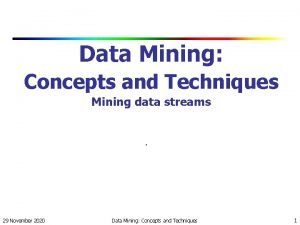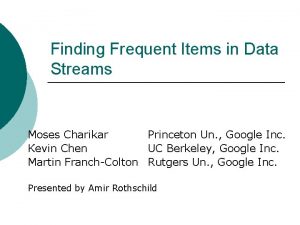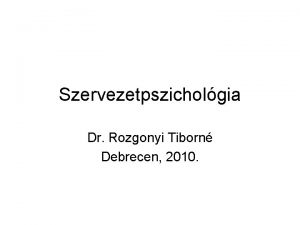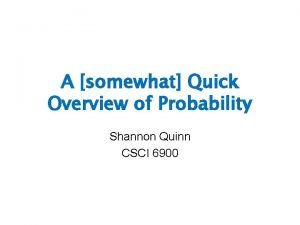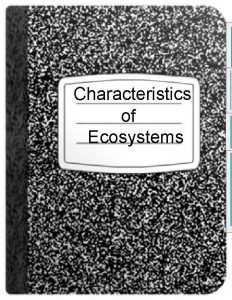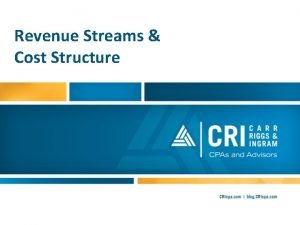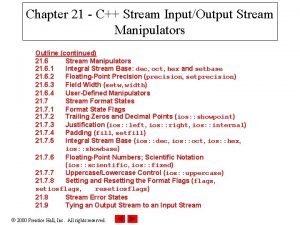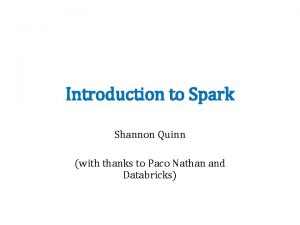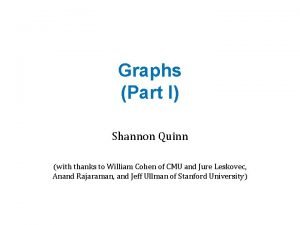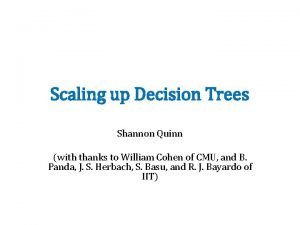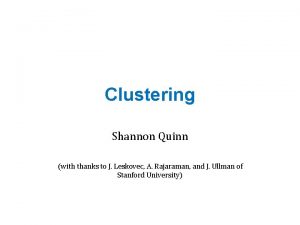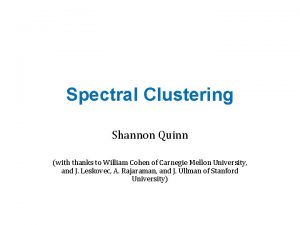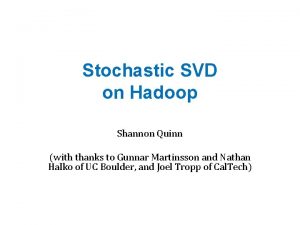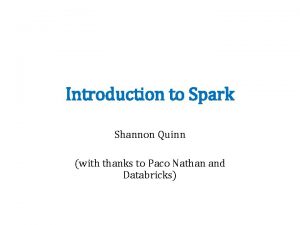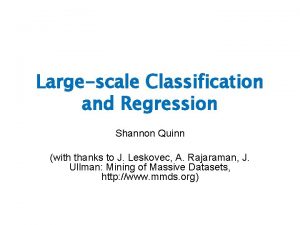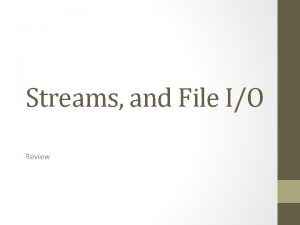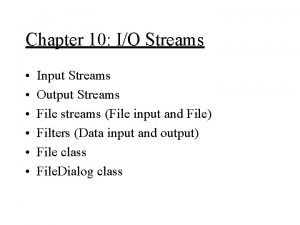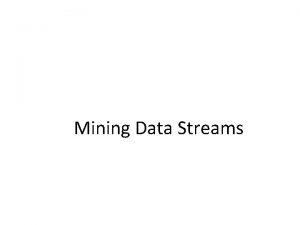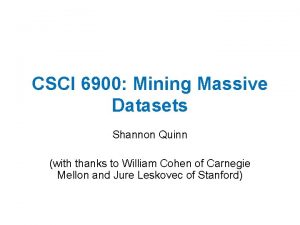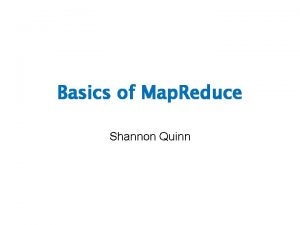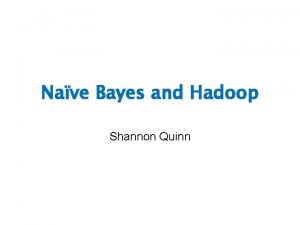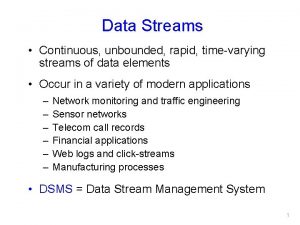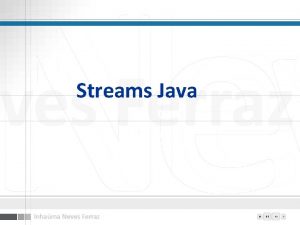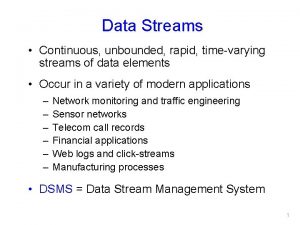More on Data Streams Shannon Quinn with thanks























![DGIM Method [Datar, Gionis, Indyk, Motwani] • J. Leskovec, A. Rajaraman, J. Ullman: Mining DGIM Method [Datar, Gionis, Indyk, Motwani] • J. Leskovec, A. Rajaraman, J. Ullman: Mining](https://slidetodoc.com/presentation_image_h2/90d32d0404764b2b39515279ebabb10f/image-24.jpg)

![Beyond Naïve Bayes: Some Other Efficient [Streaming] Learning Methods Shannon Quinn (with thanks to Beyond Naïve Bayes: Some Other Efficient [Streaming] Learning Methods Shannon Quinn (with thanks to](https://slidetodoc.com/presentation_image_h2/90d32d0404764b2b39515279ebabb10f/image-26.jpg)






- Slides: 32

More on Data Streams Shannon Quinn (with thanks to J. Leskovec, A. Rajaraman, J. Ullman: Mining of Massive Datasets, http: //www. mmds. org)

Data Streams • In many data mining situations, we do not know the entire data set in advance • Stream Management is important when the input rate is controlled externally: – Google queries – Twitter or Facebook status updates • We can think of the data as infinite and non-stationary (the distribution changes over time) J. Leskovec, A. Rajaraman, J. Ullman: Mining of Massive Datasets, 2

The Stream Model • Input elements enter at a rapid rate, at one or more input ports (i. e. , streams) – We call elements of the stream tuples • The system cannot store the entire stream accessibly • Q: How do you make critical calculations about the stream using a limited amount of (secondary) memory? J. Leskovec, A. Rajaraman, J. Ullman: Mining of Massive Datasets, 3

Side note: NB is a Streaming Alg. • Naïve Bayes (NB) is an example of a stream algorithm • In Machine Learning we call this: Online Learning – Allows for modeling problems where we have a continuous stream of data – We want an algorithm to learn from it and slowly adapt to the changes in data • Idea: Do slow updates to the model – (NB, SVM, Perceptron) makes small updates – So: First train the classifier on training data. – Then: For every example from the stream, we slightly update the model (using small learning rate) J. Leskovec, A. Rajaraman, J. Ullman: Mining of Massive Datasets, 4

General Stream Processing Model Ad-Hoc Queries Standing Queries . . . 1, 5, 2, 7, 0, 9, 3 Output . . . a, r, v, t, y, h, b. . . 0, 0, 1, 1, 0 time Streams Entering. Each is stream is composed of elements/tuples Processor Limited Working Storage Archival Storage J. Leskovec, A. Rajaraman, J. Ullman: Mining of Massive Datasets, http: //www. mmds. org 5

Problems on Data Streams • Types of queries one wants on answer on a data stream: (we’ll do these today) – Sampling data from a stream • Construct a random sample – Queries over sliding windows • Number of items of type x in the last k elements of the stream J. Leskovec, A. Rajaraman, J. Ullman: Mining of Massive Datasets, 6

Problems on Data Streams • Other types of queries one wants on answer on a data stream: – Filtering a data stream • Select elements with property x from the stream – Counting distinct elements • Number of distinct elements in the last k elements of the stream – Estimating moments • Estimate avg. /std. dev. of last k elements – Finding frequent elements J. Leskovec, A. Rajaraman, J. Ullman: Mining of Massive Datasets, 7

Applications (1) • Mining query streams – Google wants to know what queries are more frequent today than yesterday • Mining click streams – Yahoo wants to know which of its pages are getting an unusual number of hits in the past hour • Mining social network news feeds – E. g. , look for trending topics on Twitter, Facebook J. Leskovec, A. Rajaraman, J. Ullman: Mining of Massive Datasets, 8

Applications (2) • Sensor Networks – Many sensors feeding into a central controller • Telephone call records – Data feeds into customer bills as well as settlements between telephone companies • IP packets monitored at a switch – Gather information for optimal routing – Detect denial-of-service attacks J. Leskovec, A. Rajaraman, J. Ullman: Mining of Massive Datasets, 9

Sampling from a Data Stream • Since we can not store the entire stream, one obvious approach is to store a sample • Two different problems: – (1) Sample a fixed proportion of elements in the stream (say 1 in 10) – (2) Maintain a random sample of fixed size over a potentially infinite stream • At any “time” k we would like a random sample of s elements – What is the property of the sample we want to maintain? For all time steps k, each of k elements seen so far J. Leskovec, A. Rajaraman, J. Ullman: has of Massive Datasets, equal prob. Mining of being sampled 10

Sampling a Fixed Proportion • Problem 1: Sampling fixed proportion • Scenario: Search engine query stream – Stream of tuples: (user, query, time) – Answer questions such as: How often did a user run the same query in a single days – Have space to store 1/10 th of query stream • Naïve solution: – Generate a random integer in [0. . 9] for each query – Store the query if the integer is 0, otherwise discard J. Leskovec, A. Rajaraman, J. Ullman: Mining of Massive Datasets, 11

Problem with Naïve Approach • 12

Solution: Sample Users Solution: • Pick 1/10 th of users and take all their searches in the sample • Use a hash function that hashes the user name or user id uniformly into 10 buckets J. Leskovec, A. Rajaraman, J. Ullman: Mining of Massive Datasets, 13

Generalized Solution • Stream of tuples with keys: – Key is some subset of each tuple’s components • e. g. , tuple is (user, search, time); key is user – Choice of key depends on application • To get a sample of a/b fraction of the stream: – Hash each tuple’s key uniformly into b buckets – Pick the tuple if its hash value is at most a Hash table with b buckets, pick the tuple if its hash value is at most a. How to generate a 30% sample? Hash into b=10 buckets, take the tuple if it hashes to one of the first 3 buckets 14

Maintaining a fixed-size sample • Problem 2: Fixed-size sample • Suppose we need to maintain a random sample S of size exactly s tuples – E. g. , main memory size constraint • Why? Don’t know length of stream in advance • Suppose at time n we have seen n items – Each item is in the sample S with equal prob. s/n How to think about the problem: say s = 2 Stream: a x c y z k c d e g… At n= 5, each of the first 5 tuples is included in the sample S with equal prob. At n= 7, each of the first 7 tuples is included in the sample S with equal prob. Impractical solution would be to store all the n tuples seen so far and out of them pick s at random 15

Solution: Fixed Size Sample • Algorithm (a. k. a. Reservoir Sampling) – Store all the first s elements of the stream to S – Suppose we have seen n-1 elements, and now the nth element arrives (n > s) • With probability s/n, keep the nth element, else discard it • If we picked the nth element, then it replaces one of the s elements in the sample S, picked uniformly at random • Claim: This algorithm maintains a sample S with the desired property: – After n elements, the sample contains each element seen so far with probability s/n 16

Proof: By Induction • We prove this by induction: – Assume that after n elements, the sample contains each element seen so far with probability s/n – We need to show that after seeing element n+1 the sample maintains the property • Sample contains each element seen so far with probability s/(n+1) • Base case: – After we see n=s elements the sample S has the desired property • Each out of n=s elements is in the sample with probability s/s = 1 J. Leskovec, A. Rajaraman, J. Ullman: Mining of Massive Datasets, 17

Proof: By Induction • Element n+1 discarded Element n+1 not discarded Element in the sample not picked J. Leskovec, A. Rajaraman, J. Ullman: Mining of Massive Datasets, 18

Sliding Windows • A useful model of stream processing is that queries are about a window of length N – the N most recent elements received • Interesting case: N is so large that the data cannot be stored in memory, or even on disk – Or, there are so many streams that windows for all cannot be stored • Amazon example: – For every product X we keep 0/1 stream of whether that product was sold in the n-th transaction – We want answer queries, how many times have we sold X in the last k sales J. Leskovec, A. Rajaraman, J. Ullman: Mining of Massive Datasets, 19

Sliding Window: 1 Stream • Sliding window on a single stream: N=6 qwertyuiopasdfghjklzxcvbnm Past Future J. Leskovec, A. Rajaraman, J. Ullman: Mining of Massive Datasets, 20

Counting Bits (1) • Problem: – Given a stream of 0 s and 1 s – Be prepared to answer queries of the form How many 1 s are in the last k bits? where k ≤ N • Obvious solution: Store the most recent N bits – When new bit comes in, discard the N+1 st Suppose N=6 bit 0 1 0 0 1 1 1 0 1 0 1 1 0 Past Future J. Leskovec, A. Rajaraman, J. Ullman: Mining of Massive Datasets, 21

Counting Bits (2) • You can not get an exact answer without storing the entire window • Real Problem: What if we cannot afford to store N bits? – E. g. , we’re processing 1 billion streams and N = 1 billion 0 1 0 0 1 1 1 0 1 0 1 1 0 Past Future • But we are happy with an approximate answer J. Leskovec, A. Rajaraman, J. Ullman: Mining of Massive Datasets, 22

An attempt: Simple solution • N 0100111000101001011011011100101011010 Past J. Leskovec, A. Rajaraman, J. Ullman: Mining of Massive Datasets, Future 23
![DGIM Method Datar Gionis Indyk Motwani J Leskovec A Rajaraman J Ullman Mining DGIM Method [Datar, Gionis, Indyk, Motwani] • J. Leskovec, A. Rajaraman, J. Ullman: Mining](https://slidetodoc.com/presentation_image_h2/90d32d0404764b2b39515279ebabb10f/image-24.jpg)
DGIM Method [Datar, Gionis, Indyk, Motwani] • J. Leskovec, A. Rajaraman, J. Ullman: Mining of Massive Datasets, 24

Summary • Sampling a fixed proportion of a stream – Sample size grows as the stream grows • Sampling a fixed-size sample – Reservoir sampling • Counting the number of 1 s in the last N elements – Exponentially increasing windows – Extensions: • Number of 1 s in any last k (k < N) elements • Sums of integers in the last N elements J. Leskovec, A. Rajaraman, J. Ullman: Mining of Massive Datasets, 25
![Beyond Naïve Bayes Some Other Efficient Streaming Learning Methods Shannon Quinn with thanks to Beyond Naïve Bayes: Some Other Efficient [Streaming] Learning Methods Shannon Quinn (with thanks to](https://slidetodoc.com/presentation_image_h2/90d32d0404764b2b39515279ebabb10f/image-26.jpg)
Beyond Naïve Bayes: Some Other Efficient [Streaming] Learning Methods Shannon Quinn (with thanks to William Cohen)

Rocchio’s algorithm • Relevance Feedback in Information Retrieval, SMART Retrieval System Experiments in Automatic Document Processing, 1971, Prentice Hall Inc.

Rocchio’s algorithm Many variants of these formulae …as long as u(w, d)=0 for words not in d! Store only non-zeros in u(d), so size is O(|d| ) But size of u(y) is O(|n. V| )

Rocchio’s algorithm Given a table mapping w to DF(w), we can compute v(d) from the words in d…and the rest of the learning algorithm is just adding…

A hidden agenda • Part of machine learning is good grasp of theory • Part of ML is a good grasp of what hacks tend to work • These are not always the same – Especially in big-data situations • Catalog of useful tricks so far – Brute-force estimation of a joint distribution – Naive Bayes – Stream-and-sort, request-and-answer patterns – BLRT and KL-divergence (and when to use them) – TF-IDF weighting – especially IDF • it’s often useful even when we don’t understand why

Two fast algorithms This isn’t silly – often there are • Naïve Bayes: one pass features that are “noisy” • Rocchio: two passes duplicates, or important – if vocabulary fits in memory phrases of different length • Both method are algorithmically similar – count and combine • Thought thought thought thought experiment: what if we duplicated some features in our dataset many times times times? – e. g. , Repeat all words that start with “t” “t” “t” ten ten ten times times times. – Result: some features will be over-weighted in classifier

Two fast algorithms This isn’t silly – often there are features that are “noisy” duplicates, or important phrases of different length • Naïve Bayes: one pass • Rocchio: two passes – if vocabulary fits in memory • Both method are algorithmically similar – count and combine • Result: some features will be over-weighted in classifier – unless you can somehow notice are correct for interactions/dependencies between features • Claim: naïve Bayes is fast because it’s naive
 More more more i want more more more more we praise you
More more more i want more more more more we praise you More more more i want more more more more we praise you
More more more i want more more more more we praise you Data nugget streams as sensors answers
Data nugget streams as sensors answers Basic concepts in mining data streams
Basic concepts in mining data streams A framework for clustering evolving data streams
A framework for clustering evolving data streams Finding frequent items in data streams
Finding frequent items in data streams Meaning of edel quinn
Meaning of edel quinn Richard quinn ucf cheating
Richard quinn ucf cheating Darwin quinn
Darwin quinn Self – marc quinn, 1991
Self – marc quinn, 1991 Oh mary conceived without sin
Oh mary conceived without sin John quinn beaumont
John quinn beaumont Ashlynn quinn
Ashlynn quinn Versengő értékek modell
Versengő értékek modell Instrumento ocai de cameron y quinn
Instrumento ocai de cameron y quinn Duane quinn
Duane quinn Feargal quinn
Feargal quinn Self – marc quinn, 1991
Self – marc quinn, 1991 Jim quinn net worth
Jim quinn net worth Nccbp
Nccbp Strongback bridging
Strongback bridging Paulyn marrinan quinn
Paulyn marrinan quinn Unos region 5
Unos region 5 Jenny tsang-quinn
Jenny tsang-quinn Quinn prob
Quinn prob Youtube
Youtube Characteristics of wetlands
Characteristics of wetlands Cost streams
Cost streams Oracle streams
Oracle streams Groundwater table
Groundwater table Female figure holding a fly-whisk
Female figure holding a fly-whisk Sand dune migration
Sand dune migration Streams in c++
Streams in c++



